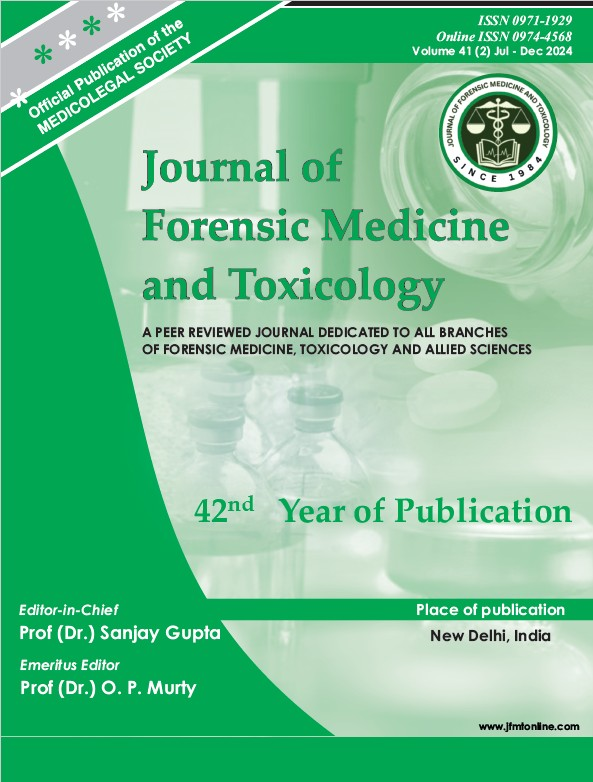STUDY OF MORPHOLOGY (GROSS) AND HISTOPATHOLOGY OF LIGATURE MARK IN HANGING AND LIGATURE STRANGULATION IN HUMAN POPULATION OF AJMER DISTRICT, RAJASTHAN (INDIA)
Keywords:
Asphyxial death, hanging, ligature strangulation, morphology, histopathologyAbstract
In humans, hanging is one of the most common method of suicide in the society.The present study was conducted with the basic aim to find out the morphological and hispathological findings in muscle tissue in ligature strangulation three 3 (75%) cases, as compare to hanging 40 (44.4%) . Perifollicular congestion and hemorrhage were the commonest hispathological findings in the thyroid gland in both hanging and ligature strangulation. Follicular hemorrhage was not found in hanging as well as in ligature strangulation..
Downloads
References
Rappai R, Cherian A V, Lukose A and Lakshmi V. Suicide research in India: An overview of four decades. Asian Journal of Psychiatry. 2000: 53 https:/ /doi.org/10.1016/j.ajp.2020.102191.
Radhakrishnan R and Andrade C. Suicide: An Indian perspective. Indian Journal of Psychiatry. 2000; 54 (4): 304-319.
Keithmant A. Taylor’s Principles and practice of Medical Jurisprudence; 13th edition, Churchill livingstone, 1995; 282-322.
Reddy KSN. The essentials of forensic medicine and toxicology. 2017, 34th ed. Hyderabad: Om Sai Graphics. 5. Sharma N, Shrivastava A, Vyas P C. A Study of Morphology and Histopathology of Ligature Marks in Asphyxial Deaths by Compression of Neck in
Jodhpur Region, Rajasthan. Journal of Medical Science and Clinical Research, 2018, 6 (6): 923-929.
Gordon I and Shapiro, H A. Forensic Medicine (A Guide to Principles) 3rd edition Churchill living Stone Edinburg London, 1988, P-110-114.
Jaenseen, W. Strangulations : Hanging-Choking Throttling, in Forensic Histopathology. 1984, 214-223. 8. Bedrin I M, Levin V N, Rumiantsev I I. Materials for the study of microcirculation routes in forensic medical practice. Sudebno-Meditsinskaia Ekspertiza, 1973, 16(3), 3-8.
Sigrist T, Germann U and Markwalder C. Using muscle histology for assessment of vitality in hanging. Arch Kriminol. 1997 Sep-Oct; 200(3-4) 107-112. PMID: 9446521.
Koops E and Brinkmann B. Suicidal Strangulation by ligature (Author Transl) Zeitschrift Fur Rechtsmedizin. Journal of Legal Medicine,01 Jan 1982, 88(3): 221-231.
Oxaloacetate and
adenosinetriphosphate levels during inhibition and activation of succinate oxidation. Biochemical and biophysical research communications, 1961, 4(1), 43- 47.
Nannetti, L. On the presence of intrafollicular crystals in the thyroid of persons killed by hanging. Bollettino della Societa italiana di biologia sperimentale, 1972, 48(3), 50-52.
Wenyou N, Junzhu H, Xinmun Z. A new staining method for constriction marks in skin. Forensic Science International. 1991, 50:147-152.
Momonchand A, Meeradevi T H, Fimate L. Violent asphyxia death in Imphal. Journal of Forensic Medicine & Toxicology. 1998, 15(1):60-64.
Sharma. GA Sunil Kumar, Murty O.P. , Dogra T.D. Study of ligature mark in asphyxia deaths of Hanging and Strangulation, International Journal of Medical Toxicology and Legal Medicine, 2002, Vol. - 4 (2),
Patil B S, Garampalli S S, Pejavar S R, Ramtake A K. An Analysis of Deaths due to Hanging. Indian Journal of Forensic Medicine & Toxicology. January-June 2015, Vol. 9, No. 12-15
Prasad J K , Khalid A M, Narayana B L, Prakash B G, Kumar D S S, Reddy K B. Ligature Mark in Hanging – Gross and Histopathological Examination with Evaluation and Review. Indian Journal of Forensic Medicine & Toxicology, 2017, 11( 1): 22-26.




